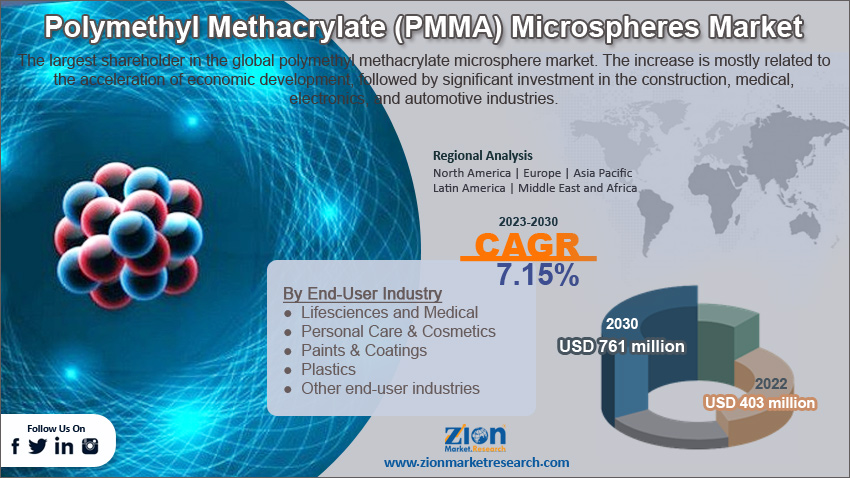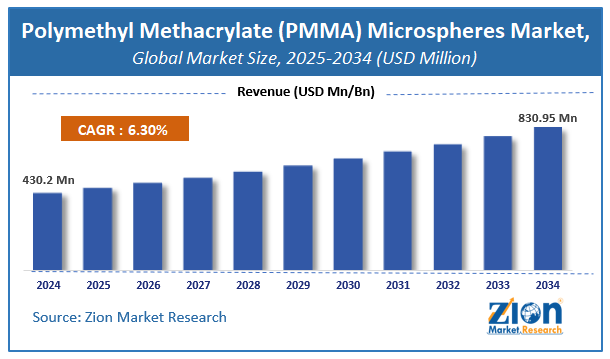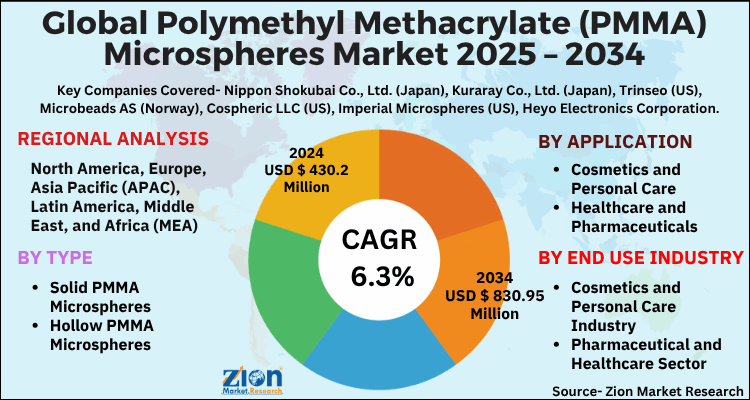Global Polymethyl Methacrylate (PMMA) Microspheres Market Size, Share - Forecast 2034

Polymethyl Methacrylate (PMMA) Microspheres Market By Type (Solid PMMA Microspheres, Hollow PMMA Microspheres), By Application (Cosmetics and Personal Care, Healthcare and Pharmaceuticals, Construction and Coatings, Automotive and Aerospace), By End Use Industry (Cosmetics and Personal Care Industry, Pharmaceutical and Healthcare Sector, Building & Construction Industry, Automotive and Aerospace Industry), and By Region: Global and Regional Industry Overview, Market Intelligence, Comprehensive Analysis, Historical Data, and Forecasts 2025 - 2034
| Market Size in 2024 | Market Forecast in 2034 | CAGR (in %) | Base Year |
|---|---|---|---|
| USD 430.2 Million | USD 830.95 Million | 6.3% | 2024 |
Global Polymethyl Methacrylate (PMMA) Microspheres Market: Industry Perspective
The global polymethyl methacrylate (PMMA) microspheres market size was worth around USD 430.2 Million in 2024 and is predicted to grow to around USD 830.95 Million by 2034 with a compound annual growth rate (CAGR) of roughly 6.3% between 2025 and 2034. The report analyzes the global polymethyl methacrylate (PMMA) microspheres market's drivers, restraints/challenges, and the effect they have on the demands during the projection period. In addition, the report explores emerging opportunities in the polymethyl methacrylate (PMMA) microspheres industry.
Global Polymethyl Methacrylate (PMMA) Microspheres Market: Overview
Poly (methyl methacrylate), PMMA, or acrylic microspheres and spheres are clear thermoplastic spherical polymer beads made from methyl methacrylate polymer. These minuscule spheres are made of polymethyl methacrylate, a clear thermoplastic noted for its optical purity and durability. PMMA microspheres are used in a variety of applications, including medicine, cosmetics, and research. They are used in medicine as embolic agents for minimally invasive procedures, drug delivery vehicles, and components of medical devices. PMMA microspheres are used in cosmetics to add texture, opacity, and mattifying qualities to a variety of products. Their consistent size distribution and compatibility with many substances make them ideal instruments in scientific studies, such as particle size analysis and flow visualization. Overall, PMMA microspheres have a wide range of qualities that make them beneficial in a variety of businesses.
 Request Free Sample
Request Free Sample
Global Polymethyl Methacrylate (PMMA) Microspheres Market: Growth Drivers
Increasing demand for Polymethyl Methacrylate (PMMA) Microspheres in the medical industry to drive market growth during the forecast period.
Polymethyl methacrylate (PMMA) microspheres are in high demand in medical applications due to their critical role in minimally invasive treatments such as embolization. PMMA microspheres are used as a dependable embolic agent to occlude blood vessels and treat disorders such as cancer and vascular abnormalities. Their exact size and biocompatibility provide excellent targeting, avoiding the need for invasive operations. PMMA microspheres are also useful in drug delivery systems and tissue engineering, allowing for regulated release and improving therapeutic effects. This increase in medical use is being driven by a need for less intrusive treatments, better patient outcomes, and enhanced medical technology, highlighting the critical role of PMMA microspheres in influencing the future of medical operations. For example, PMMA microspheres-based artificial bone cement is also widely used in orthopedics, owing to its great mechanical properties.
Restraints:
High cost of production is likely to stymie market growth
The sophisticated manufacturing methods required to produce uniformly and accurately sized microspheres lead to increased production costs. These expenses are a result of variables such as the requirement for specialized equipment, careful control of polymerization conditions, and difficulties in maintaining uniform size distribution. The expenses of making PMMA microspheres have an influence on their affordability and accessibility, potentially restricting their use in a variety of sectors. For instance, the specialized polymethyl methacrylate microspheres cost around USD 400 to USD 800 per Kg. Medical devices, cosmetics, and research industries that use PMMA microspheres must frequently examine the economic feasibility of incorporating these microspheres into their products or processes. For example, in the cosmetics industry, PMMA microspheres are often used as fillers and opacifiers. However, their high cost can make them a less attractive option for manufacturers of budget-friendly cosmetics.
PMMA microspheres are made from a relatively expensive raw material, acrylic acid. In addition, the production process for PMMA microspheres is relatively complex, which also contributes to their high cost. The production process involves a number of steps, including polymerization, precipitation, and drying. Each of these steps requires the use of specialized equipment and can be energy-intensive. As a result, the cost of producing PMMA microspheres is higher than the cost of producing other types of microspheres, such as polystyrene and PTFE.
Opportunities:
Customization and tailored solutions to offer new market growth opportunities
In the polymethyl methacrylate (PMMA) microspheres market, customization, and personalized solutions entail manufacturing microspheres with exact qualities to fulfill specific industrial demands. Industries such as medicine, cosmetics, and research can improve performance by designing PMMA microspheres with customized diameters, surface functions, and drug-loading capabilities. Microspheres tailored for precise embolization or drug release patterns, for example, enhance medical applications by improving treatment results. Cosmetics benefit from tailored microspheres that provide distinct textures and effects. Standardized particles with unique characteristics provide accurate trials in the study. This strategy creates opportunities for specialty applications, responsive materials, and long-term solutions, boosting innovation and competitiveness. Customization therefore enables enterprises to effectively handle issues, propelling the growth and diversity of the PMMA microspheres market.
Challenges:
Environmental impact to challenge the market growth
The environmental effect of PMMA microspheres is a developing problem due to their manufacturing, usage, and disposal. While PMMA is less harmful to the environment than other polymers, issues continue. The energy-intensive manufacturing process leads to carbon emissions and resource usage. Microplastic contamination can occur as a result of disposal, damaging ecosystems and aquatic life. The longevity of PMMA raises concerns about its long-term presence in the environment. Increased environmental consciousness pushes enterprises to seek out sustainable materials and processes, which may have an influence on PMMA microsphere uptake. Environmental implications are increasingly being scrutinized by regulatory organizations, which might lead to stricter rules. Developing biodegradable alternatives and investigating recycling technologies might help lessen the damage. Collaborative initiatives and life cycle evaluations are critical for resolving these challenges and encouraging appropriate usage. It is important to note that PMMA microspheres are not inherently harmful to the environment. However, the way in which they are produced and disposed of can have a negative impact on the environment.
Key Insights
- As per the analysis shared by our research analyst, the global polymethyl methacrylate (PMMA) microspheres market is estimated to grow annually at a CAGR of around 6.3% over the forecast period (2025-2034).
- Regarding revenue, the global polymethyl methacrylate (PMMA) microspheres market size was valued at around USD 430.2 Million in 2024 and is projected to reach USD 830.95 Million by 2034.
- The polymethyl methacrylate (PMMA) microspheres market is projected to grow at a significant rate due to increasing demand for high-performance materials in healthcare, cosmetics, and displays, rising adoption in 3D printing and advanced coatings, and growing focus on sustainable and biocompatible solutions.
- Based on Type, the Solid PMMA Microspheres segment is expected to lead the global market.
- On the basis of Application, the Cosmetics and Personal Care segment is growing at a high rate and will continue to dominate the global market.
- Based on the End Use Industry, the Cosmetics and Personal Care Industry segment is projected to swipe the largest market share.
- Based on region, Asia-Pacific is predicted to dominate the global market during the forecast period.
Global Polymethyl Methacrylate (PMMA) Microspheres Market: Report Scope
| Report Attributes | Report Details |
|---|---|
| Report Name | Polymethyl Methacrylate (PMMA) Microspheres Market |
| Market Size in 2024 | USD 430.2 Million |
| Market Forecast in 2034 | USD 830.95 Million |
| Growth Rate | CAGR of 6.3% |
| Number of Pages | 211 |
| Key Companies Covered | Nippon Shokubai Co., Ltd. (Japan), Kuraray Co., Ltd. (Japan), Trinseo (US), Microbeads AS (Norway), Cospheric LLC (US), Imperial Microspheres (US), Heyo Electronics Corporation (Taiwan), Kobo Products Inc. (US), Lab261 (US), and others. |
| Segments Covered | By Type, By Application, By End Use Industry, and By Region |
| Regions Covered | North America, Europe, Asia Pacific (APAC), Latin America, The Middle East and Africa (MEA) |
| Base Year | 2024 |
| Historical Year | 2020 to 2023 |
| Forecast Year | 2025 - 2034 |
| Customization Scope | Avail customized purchase options to meet your exact research needs. Request For Customization |
Global Polymethyl Methacrylate (PMMA) Microspheres Market: Segmentation
The global Polymethyl Methacrylate (PMMA) Microspheres market is segmented based on size, application, end-user industry, and region. All the segments have been analyzed based on present and future trends and the market is estimated from 2025 to 2034.
Based on size, the global market segments are 0 to 30 microns and above 30 microns. At present, the polymethyl methacrylate microspheres industry is dominated by the 0–30 micron segment. This is due to the fact that this size range is appropriate for applications requiring opacity and bulk, such as cosmetics, paints, and coatings. This size range of PMMA microspheres may provide opacity and bulk to goods without making them feel heavy or thick. They are also reasonably priced, making them an attractive alternative for cost-conscious producers. PMMA microspheres above 30 microns are also used in a variety of applications, but they are not as widely used as the 0–30 micron size range. This is because they are more expensive and can make products feel heavy or thick. However, they can provide specific properties that are not available with smaller microspheres, such as high strength and durability.
Based on application, the global polymethyl methacrylate microspheres market is categorized into signs & displays, cosmetic additives, paints & ink additives, polymers & films, and other applications. Out of these, cosmetic additives had the largest shareholding segment in the global market. This is because PMMA microspheres can provide a number of benefits in cosmetics, such as opacity, bulk, and sunscreen protection. They are also relatively inexpensive, which makes them a good option for cost-conscious manufacturers. For example, polymethylmethacrylate (PMMA) microspheres have been widely used in the correction of wrinkles because of their long-lasting cosmetic improvements.
Based on end-user industry, the global polymethyl methacrylate microspheres industry is categorized into life-sciences and medical, personal care & cosmetics, paints & coatings, plastics, and other end-user industries. The end-user industry of PMMA microspheres has the largest shareholding in the life sciences & medical segment. This is because PMMA microspheres are used in a variety of medical applications, such as drug delivery, tissue engineering, and diagnostics. They are also relatively inexpensive, which makes them a good option for cost-conscious manufacturers. For example, PMMA microspheres can be used to create scaffolds for tissue engineering. This makes them a good option for growing new tissues such as bone, cartilage, and skin.
The Regional, this segment includes the current and forecast demand for North America, Europe, Asia Pacific, Latin America,and the Middle East and Africa.
Global Polymethyl Methacrylate (PMMA) Microspheres Market: Regional Analysis
The Polymethyl Methacrylate (PMMA) microspheres market exhibits varied regional dynamics, with Asia-Pacific leading due to rapid industrialization, expanding electronics manufacturing, and rising demand for advanced coatings and medical applications in countries like China, Japan, and South Korea. North America follows closely, driven by significant usage in life sciences, diagnostics, and high-performance coatings, supported by strong research activities and technological advancements. Europe maintains steady growth, fueled by applications in automotive, medical devices, and cosmetics, underpinned by strict quality standards and sustainability initiatives. Meanwhile, regions like Latin America and the Middle East & Africa are gradually expanding, propelled by growing industrial sectors and increasing adoption of PMMA microspheres in niche applications, although their market share remains relatively smaller compared to established regions.
Global Polymethyl Methacrylate (PMMA) Microspheres Market: Competitive Analysis
The report provides a company market share analysis to give a broader overview of the key market players. In addition, the report also covers key strategic developments of the market, including acquisitions & mergers, new product launches, agreements, partnerships, collaborations & joint ventures, research & development, and regional expansion of major participants involved in the polymethyl methacrylate (PMMA) microspheres market on a global and regional basis.
The global polymethyl methacrylate (PMMA) microspheres market is dominated by players like:
- Nippon Shokubai Co. Ltd. (Japan)
- Kuraray Co. Ltd. (Japan)
- Trinseo (US)
- Microbeads AS (Norway)
- Cospheric LLC (US)
- Imperial Microspheres (US)
- Heyo Electronics Corporation (Taiwan)
- Kobo Products Inc. (US)
- Lab261 (US)
Global Polymethyl Methacrylate (PMMA) Microspheres Market: Segmentation Analysis
The global polymethyl methacrylate (PMMA) microspheres market is segmented as follows;
By Type
- Solid PMMA Microspheres
- Hollow PMMA Microspheres
By Application
- Cosmetics and Personal Care
- Healthcare and Pharmaceuticals
- Construction and Coatings
- Automotive and Aerospace
By End Use Industry
- Cosmetics and Personal Care Industry
- Pharmaceutical and Healthcare Sector
- Building & Construction Industry
- Automotive and Aerospace Industry
Global Polymethyl Methacrylate (PMMA) Microspheres Market: Regional Segment Analysis
- North America
- The U.S.
- Canada
- Mexico
- Europe
- France
- The UK
- Spain
- Germany
- Italy
- Rest of Europe
- Asia Pacific
- China
- Japan
- India
- Australia
- South Korea
- Rest of Asia Pacific
- The Middle East & Africa
- Saudi Arabia
- UAE
- Egypt
- Kuwait
- South Africa
- Rest of the Middle East & Africa
- Latin America
- Brazil
- Argentina
- Rest of Latin America
Table Of Content
Methodology
FrequentlyAsked Questions
Poly (methyl methacrylate), PMMA, or acrylic microspheres and spheres are clear thermoplastic spherical polymer beads made from methyl methacrylate polymer. These minuscule spheres are made of polymethyl methacrylate, a clear thermoplastic noted for its optical purity and durability. PMMA microspheres are used in a variety of applications, including medicine, cosmetics, and research. They are used in medicine as embolic agents for minimally invasive procedures, drug delivery vehicles, and components of medical devices.
The global polymethyl methacrylate (PMMA) microspheres market is expected to grow due to rising demand in medical, cosmetics, and coatings industries, along with advancements in drug delivery systems and increasing applications in diagnostics and biotechnology.
According to a study, the global polymethyl methacrylate (PMMA) microspheres market size was worth around USD 430.2 Million in 2024 and is expected to reach USD 830.95 Million by 2034.
The global polymethyl methacrylate (PMMA) microspheres market is expected to grow at a CAGR of 6.3% during the forecast period.
Asia-Pacific is expected to dominate the polymethyl methacrylate (PMMA) microspheres market over the forecast period.
Leading players in the global polymethyl methacrylate (PMMA) microspheres market include Nippon Shokubai Co., Ltd. (Japan), Kuraray Co., Ltd. (Japan), Trinseo (US), Microbeads AS (Norway), Cospheric LLC (US), Imperial Microspheres (US), Heyo Electronics Corporation (Taiwan), Kobo Products Inc. (US), Lab261 (US), among others.
The report explores crucial aspects of the polymethyl methacrylate (PMMA) microspheres market, including a detailed discussion of existing growth factors and restraints, while also examining future growth opportunities and challenges that impact the market.
HappyClients
Zion Market Research
Tel: +1 (302) 444-0166
USA/Canada Toll Free No.+1 (855) 465-4651
3rd Floor,
Mrunal Paradise, Opp Maharaja Hotel,
Pimple Gurav, Pune 411061,
Maharashtra, India
Phone No +91 7768 006 007, +91 7768 006 008
US OFFICE NO +1 (302) 444-0166
US/CAN TOLL FREE +1 (855) 465-4651
Email: sales@zionmarketresearch.com
We have secured system to process your transaction.
Our support available to help you 24 hours a day, five days a week.
Monday - Friday: 9AM - 6PM
Saturday - Sunday: Closed






